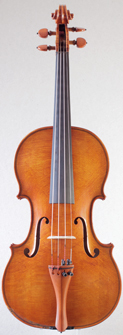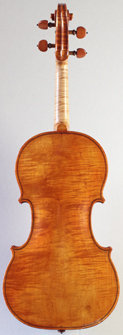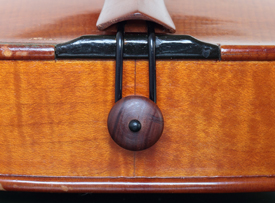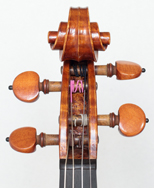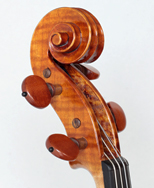Violin by Anthony Wrona, Buffalo, NY, USA, 1959
|
|
|
| |||||||||||||||
Description — Ingenious
"What an inspired violin!" was my first reaction seeing this instrument by Anthony Wrona.
It's totally aflame, all around, including the belly and all sides of
the scroll. The top's vertical annual rings appear wavy, as if heat from the
horizontal flames
made them flicker. Second-choice wood (bearclaw-marked spruce,
maple with faint figure and knots) is transcended into this
magnificent work of art. Flames seem to propagate from the belly, through the ribs, to the back
where smoke forms clouds in a tormented landscape.
The f-holes — whose wings have been exquisitely fluted — are quite upright and set
far apart.
Similarly, the pegbox walls stand upright and far apart. The volutes are wide
as well, with exquisitely-fluted back. Everything is coherent in this fiddle.
It sounds bigger than its length (35.4 cm) because the resonating volume has been cleverly
maximized.
The model is wider than standard, with ribs close to
the edges, and archings are quite high, but elegance has been preserved by
hiding the main bulge under the fingerboard, so it doesn't appear disproportioned.
Each aspect: visual, acoustic, artistic,
technical, has been designed with meaning and
realized with talent.
Varnish — Spotlighting Wood
Should the ideal varnish draw attention to itself or to
the underlying wood? In our case, the latter option was tastefully achieved.
The overcoat is discrete — transparent, thin and supple,
neither too brown nor too orange — while the undercoat's honey-yellow brilliance
highlights the depictions of the wood. A third dimension emerges from the wood's freckles
and flames. The contrast is such that the violin looks antique, with points of varying
colors next to each other. On stage, it looks like a
seasoned old violin; up close, it looks like a fascinating modern one.
Acquisition — We Met on the Internet
I purchased this outstanding violin at Tarisio.com in their June 2014 sale.
The auction was "Speculative, Restorable & Trade"
(even though this instrument and many others were absolutely fine);
there was an error in the label transcription (#190 instead of #19);
and the wood of the top does look weird on photo.
Maybe that's why people didn't fight for it.
Anyway, what a blessing! The final price was only 5,100 US dollars. I'm going to anger dealers...
There are in fact splendid, soloist instruments, in perfect shape, available on the Web at
very reasonable prices.
Tone — Omnipresent
Wow, this violin has opened up so much!
Its tonal possibilities feel infinite.
The notes just burst out, ethereal,
oily and shining, very complex, broad and resonant like in a cathedral.
I keep finding new layers of sound.
The tone isn't particularly sweet nor full, rather
has a nasal quality that makes it heard strikingly well from far. I'd even say
it sounds somewhat hollow,
which actually helps with projection, because the volume release after the attack
defines an accent that attracts attention to each note. (On the opposite, violins whose
tone is too solid tend to sound mumbling from far.)
And this Wrona doesn't hurt my ears at all. Amazingly, the sound is indirect —
it seems to come not from inside the violin,
but from outside — as though someone else was
playing in the hall and you can't quite pinpoint where.
Playability — Articulate
Response is so quick and crisp that I can play faster than on any other of
my violins.
Some violins are quick but superficial, this one is both crystal clear and warm.
This is the instrument my colleagues and I have chosen to play second
violin in our string quartet. The middle range cuts through with precision; everyone
can hear the second violin part.
Strings — Tone Development
This fiddle arrived with Pirastro Obligato strings
which sounded dull (worn off) with the E string too hard for the set.
I played Pirastro Wondertone Solos for a few months,
enjoying their sensitivity to bow nuances, but felt after a while that this Wrona's
acoustic qualities could develop more with strings that push it in a different direction.
I tried Larsen Virtuoso for a while and enjoyed them tremendously. Their
slow speed didn't matter on this fast instrument.
I then switched to Thomastik Dominant, to smooth off the rough edges and add body
to the tone.
After a few weeks, finding it started sounding small,
I tried higher-tension strings, Pirastro Evah Pirazzi, to widen its scope.
But then I missed some sweetness to the tone, and musical dynamics became difficult.
The new Pirastro Tonicas (with strong E) sounded good.
Their high-tension G string beefed up the low register nicely.
As of 2018, it's mounted with Larsen Il Cannone (regular version) and I love their
sweet, sharp tone.
I'll change strings again when sensing this violin has exhausted their potential
and needs a new start.
Bibliography
More about Anthony Wrona:
- Anthony Wrona on WronasHouseOfViolins.com.

- Wikipedia about Anthony Wrona.
- "From Violinmaking to Music: The Life and Works of Simone Fernando Sacconi", Excerpt by Anthony Wrona, on MaestroNet.com, A.C.L.A.P., Cremona, 1985, pages 66-67.
- "Tribute Concert to Honor Master Violin Maker" on BuffaloNews.com by Herman Trotter, The Buffalo News, 14 March 1992.
- Tribute Concert
to Anthony Wrona on YouTube.com, Thomas Halpin—violin, Kiyomi Shiba—piano,
State University of New York at Buffalo, 18 March 1992.

- "News: In Memoriam" on Archive.li
by Michael Wrona, Strings, February/March 2001,
vol. 15, no. 6, issue 92, page 118.

- "News & Events: Death of Sacconi's Pupil", The Strad, November 2000,
vol. 111, no. 1327, page 1177.

- The Cozio Archive about Anthony T. Wrona on Tarisio.com.

- "The Brompton's Book of Violin and Bow Makers" on Amati.com by John Dilworth, Ed. John Milnes, London, 2012, page 670.
- "Loan Exhibition of Stringed Instruments and Bows - Commemorating the Seventieth
Birthday of Simone Fernando Sacconi - New York City 1966", Schuler
Verlagsgesellschaft Stuttgart, Germany.

- Violin by Anthony Wrona, 1959, on BorisAbramov.com.

- "The Violin Makers of the United States" by Thomas J. Wenberg, Mt. Hood Publishing Company, Oregon, 1986, page 328.
- "Die Geigen- und Lautenmacher vom Mittelalter bis zur Gegenwart" by Willibald von Lütgendorff, volume 3 by Thomas Drescher, Verlegt Hans Schneider, Tutzing, Germany, 1990, pages 693-694.
Measurements & Data
Maker: Anthony T. Wrona (1926-2000)
Made in: Buffalo, New York, USA
Year: 1959
Number: 19
Back Length: 354 mm *
Upper Bouts: 169 mm *
Middle Bouts: 108 mm *
Lower Bouts: 208 mm *
Stop Length: 197 mm
Rib Height at Neck: 29 mm *
Rib Height at Endpin: 31 mm *
Thickness of the Top: 3.2 mm
Thickness of the Back: 3.9 mm
F-hole Length: 76.0 mm *
Distance Between F-holes: 42 mm *
Distance Edge-Purfling: 3.5 mm
Scroll Width: 42 mm *
Weight: 408 grams
Label:
Made by
Anthony Wrona
Buffalo N. Y. 1959
# 19
Brand: Stamped "WRONA" to the bridge.
Condition: Mint. No cracks, borders and varnish impeccable (except at chinrest). Every part looks original, including the fittings.
* measured with a caliper
Maker: Anthony T. Wrona (1926-2000)
Made in: Buffalo, New York, USA
Year: 1959
Number: 19
Back Length: 354 mm *
Upper Bouts: 169 mm *
Middle Bouts: 108 mm *
Lower Bouts: 208 mm *
Stop Length: 197 mm
Rib Height at Neck: 29 mm *
Rib Height at Endpin: 31 mm *
Thickness of the Top: 3.2 mm
Thickness of the Back: 3.9 mm
F-hole Length: 76.0 mm *
Distance Between F-holes: 42 mm *
Distance Edge-Purfling: 3.5 mm
Scroll Width: 42 mm *
Weight: 408 grams
Label:
Made by
Anthony Wrona
Buffalo N. Y. 1959
# 19
Brand: Stamped "WRONA" to the bridge.
Condition: Mint. No cracks, borders and varnish impeccable (except at chinrest). Every part looks original, including the fittings.
* measured with a caliper


